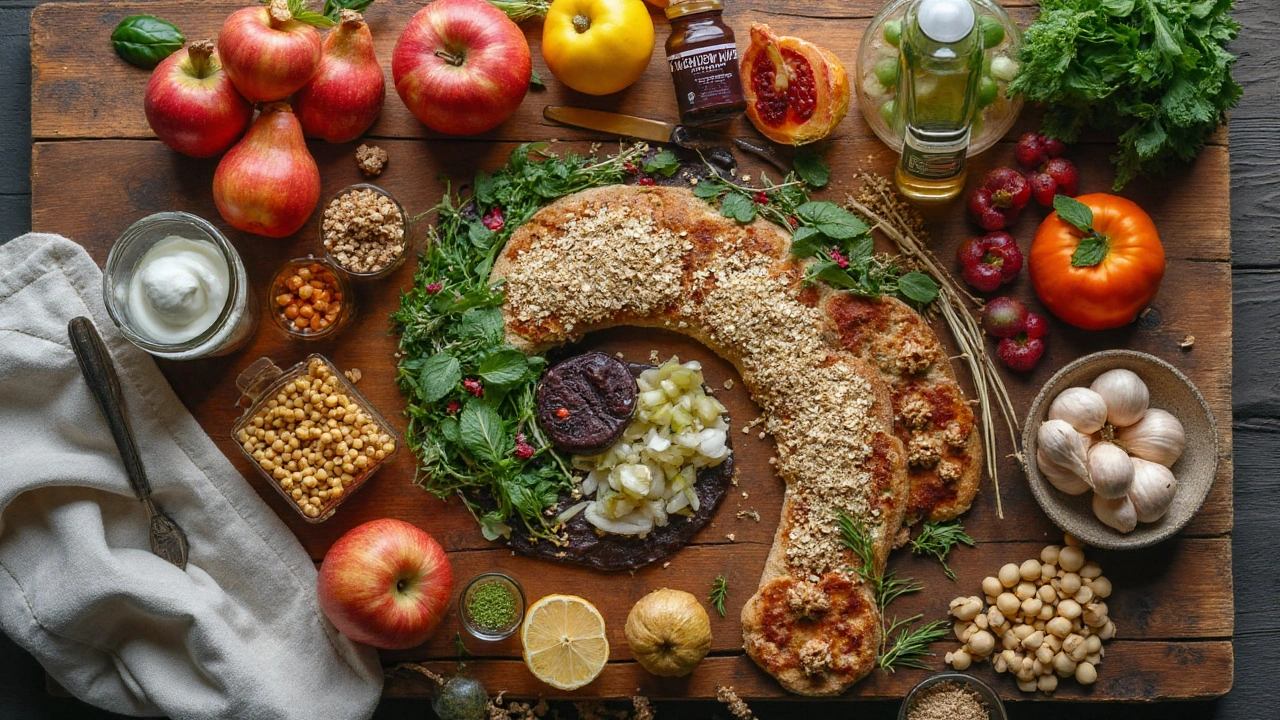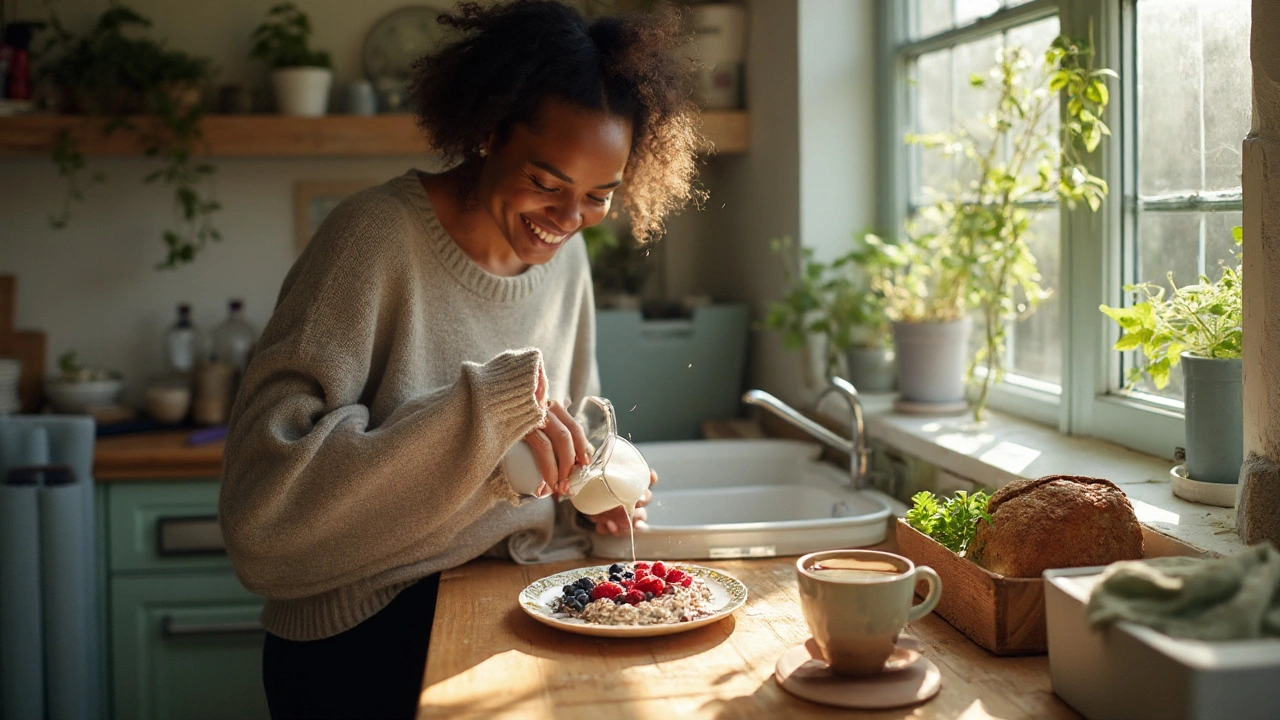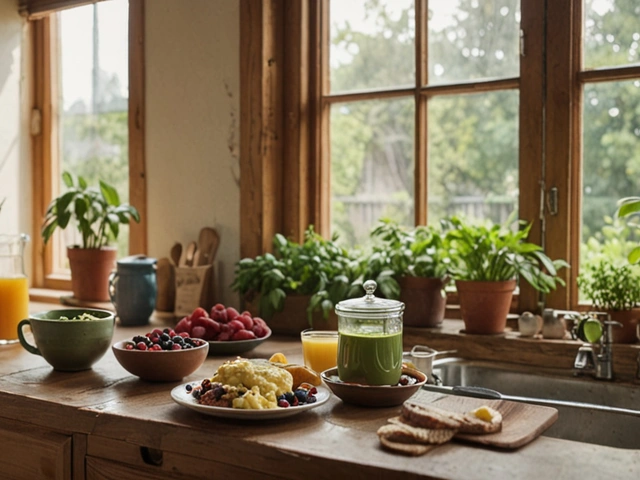Most people only think about their gut when it protests-bloating after lunch, a bathroom sprint on vacation, that random cramp in a meeting. But here’s the twist: when your gut runs well, everything else runs better. Energy is steadier. Mood lifts. Skin calms down. You even handle stress differently. This isn’t hype. It’s how your body is wired.
Quick expectation check: you don’t need a $200 probiotic, a keto cleanse, or to cut out bread forever. You need a few steady habits, a pinch of patience (weeks, not days), and simple food. I live in Vancouver and see the difference every time I swap takeout for a bowl with greens, beans, and salmon. You’ll see it too-if you give your gut a fair shot.
What you’ll get here: a tight summary, a plain-English tour of the big benefits, a step-by-step plan you can start today, simple checklists, and answers to the questions that keep popping up. My goal: help you finish this page with a plan you can actually follow.
TL;DR: The Unexpected Upsides of Good Gastro Health
- Feel it fast: steadier energy, less bloat, more regularity in 1-3 weeks; skin and mood in 4-8 weeks.
- Science-backed perks: better immunity, calmer inflammation, clearer thinking, easier weight balance.
- Core habits: 30 plants/week, daily fermented food, 25-38 g fiber, 2-3 L fluids, stress down, sleep up.
- Skip the traps: don’t jump fiber overnight, don’t “low-FODMAP” forever, don’t DIY past red flags.
- Supplements are helpers, not heroes: food first; pick a single-strain probiotic for a single job.
Jobs-to-be-done this article covers: understand why gut health matters, build a daily routine, pick the right foods, troubleshoot bloating/irregularity, know when to see a doctor, and keep momentum without obsessing.
Why Your Gut Touches Energy, Mood, Immunity, Skin, and Weight
Think of your digestive tract as a busy city. Trillions of microbes work 24/7-fermenting fiber, making short-chain fatty acids (SCFAs) like butyrate, training your immune system, and talking to your brain through nerves and hormones. When that city hums, you feel it in surprising places.
- Energy and focus: SCFAs feed your colon cells, lower low-grade inflammation, and help regulate blood sugar swings. People often notice fewer afternoon crashes once their meals include fiber and protein. A 2021 review in Gut reported that higher fiber intake is linked to better metabolic health and more stable post-meal glucose.
- Mood and stress: About 90% of the body’s serotonin is made in the gut. Microbial metabolites talk to your brain via the vagus nerve-the gut-brain axis. A 2023 review in Nature Microbiology highlighted how specific fibers and fermented foods can reduce perceived stress in a few weeks.
- Immunity: Around 70% of immune cells live along your digestive tract. A diverse microbiome “trains” the immune system so it reacts when it should and chills when it shouldn’t. A 2022 Stanford trial (Cell) showed a fermented-food-rich diet increased microbiome diversity and decreased inflammatory markers.
- Skin and inflammation: Rosacea, eczema, and acne can flare with unstable digestion. When the gut barrier is healthy, inflammatory signals calm down, and skin often follows. Dermatology and gastro journals have tracked this gut-skin loop for years; the trend is consistent: better gut habits, calmer skin.
- Weight balance: Fiber-rich diets improve satiety hormones (GLP-1, PYY) and slow digestion. People eat fewer “urgency calories” because they’re actually full. Large cohort studies and a 2019 JAMA analysis tie higher fiber to easier weight control.
Anything surprising here for 2025? Two standouts: fermented foods are finally getting credit beyond yogurt (think kefir, kimchi, miso), and “30 plants per week” is becoming the new north star for diversity.

How to Improve Your Gastro Health: A Simple Plan That Works
Start small. Stack wins. Adjust slowly. Here’s a week-by-week plan that doesn’t wreck your schedule.
- Week 1: Stabilize the basics
- Hydration: 2-3 L/day (more if you sweat). Add a pinch of salt and lemon to one bottle if you’re low-sodium or very active.
- Plate builder: half plants (veg/fruit), quarter protein, quarter smart carbs (whole grains, beans, root veg), add healthy fats.
- Easy fiber: add 1 piece of fruit + 1 cup vegetables daily. Don’t jump from 10 g to 35 g in two days; gas will revolt.
- Walk after meals: 10-15 minutes lowers bloat and blood sugar spikes. Treat this like brushing your teeth.
- Week 2: Add diversity + fermentation
- 30 plants/week: count herbs, nuts, seeds, berries, beans, whole grains. Each different item counts once. Salsa, kimchi, and mixed green salads help.
- Fermented food daily: 1-2 servings-kefir, yogurt with live cultures, sauerkraut, kimchi, miso, tempeh. Start with a few forkfuls if you’re sensitive.
- Protein sanity: 20-30 g per meal. Protein stabilizes appetite and reduces “snack storms.”
- Week 3: Fine-tune fiber types
- Soluble fiber for sensitive guts: oats, chia, psyllium, kiwi, cooked carrots, peeled apples.
- Insoluble fiber for regularity (ease in): bran, whole grains, skins, raw salads, crucifers. Pair with water.
- Consider one gentle supplement: 1 tsp psyllium in water at night can help both constipation and loose stools. Increase slowly.
- Week 4: Lock in rhythm + stress care
- Sleep: 7-9 hours. Short sleep changes hunger hormones and makes bloating worse.
- Stress buffer: 5-10 minutes daily-box breathing (4-4-4-4), a short walk, or a quick stretch. The vagus nerve loves rhythm.
- Training: 2-3 strength sessions/week, plus daily movement. Exercise supports microbial diversity.
Rules of thumb you’ll actually use:
- The 15-bite rule: get at least 15 bites of plants per meal (a handful of greens = ~5 bites). Easy diversity hack.
- Fiber ladder: add ~5 g/day per week until you hit your target. Gas means pause, chew better, or cook your veg.
- Bean hack: start with 1/4 cup, rinse well, cook with bay leaf, add kombu if you can. Enzymes help too.
- Low-FODMAP is a tool, not a lifestyle: it’s a 2-6 week elimination under guidance, then reintroduction. Don’t stay stuck there.
- One change at a time: if you change five things and feel better (or worse), you won’t know which mattered.
Supplements: food first, but if you need a nudge:
- Probiotics: match strain to job. B. lactis HN019 and L. plantarum 299v have evidence for regularity and IBS symptoms. Give it 4-8 weeks. Don’t chase ten blends at once.
- Prebiotics: inulin or partially hydrolyzed guar gum for stool form and microbial support-start tiny to avoid gas.
- Digestive enzymes: short-term support for heavy meals, not a forever fix.
- Magnesium citrate or glycinate: evening routine for constipation-prone folks. Check meds and kidney health first.
Medication note (not medical advice): frequent NSAIDs can irritate the gut; long-term acid blockers lower stomach acid and can shift the microbiome. Talk to your clinician before making changes.
Real-World Examples, Meal Ideas, and Vancouver-Friendly Tips
Make it concrete. Here’s what a day might look like in 2025 with grocery prices and time in mind.
- Breakfast (7 min): kefir smoothie with frozen BC blueberries, spinach, chia, peanut butter, and oats. Protein, fiber, fermented dairy-done.
- Lunch (10 min): leftover quinoa tossed with chickpeas, cherry tomatoes, cucumbers, parsley, olive oil, lemon, and smoked salmon. Salt, crunch, color.
- Snack: kiwi and a handful of walnuts. Kiwi helps with regularity in small studies.
- Dinner (sheet pan): miso-glazed salmon, broccoli, and sweet potato wedges. Sprinkle sesame seeds. Add kimchi on the side if you like a kick.
Vancouver angle: shop the seasons-BC blueberries, apples, kale, cabbage, and salmon make diversity easy. If you’re on the go, a sushi roll with brown rice and avocado plus a side seaweed salad gives fiber and iodine without breaking the bank.
Common problems and quick fixes:
- Bloated by 3 p.m.: check lunch-was it low on protein and fiber but high on white carbs? Swap in beans or lentils, add greens, and walk 10 minutes.
- Constipated on travel: drink more water, carry kiwis or prunes, add 1 tsp psyllium nightly, keep moving. Skip heavy alcohol on the plane.
- Loose stools after dairy: try kefir or lactose-free yogurt; dairy fat and lactose hit people differently.
- Gas with beans: try lentils before chickpeas, rinse well, go small and slow, cook thoroughly.
Evidence snapshots that help you trust the plan:
- Fermented foods reduce inflammation and boost diversity (Stanford Cell, 2022).
- Higher fiber links to lower risk of heart disease and improved metabolic markers (Gut, 2021; JAMA meta-analyses).
- Short-term low-FODMAP helps IBS symptoms but needs reintroduction to prevent microbiome loss (American Gastroenterological Association guidance, 2021-2023).
| Daily Target | Why it helps | Easy sources | Quick swaps |
|---|---|---|---|
| Fiber 25-38 g | Feeds microbes; steadier energy; regularity | Oats, beans, chia, berries, veg, whole grains | White rice → brown/wild; chips → popcorn + nuts |
| 30 plants/week | Diversity = resilience | Herbs, spices, mixed greens, nuts, seeds | Iceberg → spring mix; basil or cilantro on everything |
| 1-2 fermented servings | Microbial diversity, lower inflammation | Kefir, yogurt, kimchi, sauerkraut, miso, tempeh | Mayo → yogurt; side salad → salad + kimchi |
| 2-3 L fluids | Stool form, digestion, energy | Water, herbal tea, broth | Sweet drinks → water + lemon + pinch of salt (if active) |
| 7-9 h sleep | Hormones, cravings, stress | Cool, dark room; steady wake time | Late screens → phone on grayscale, bedtime alarm |
| Daily movement | Motility, mood, blood sugar | Walks, stair breaks, strength 2-3x/week | Elevator → stairs; bus stop one earlier |
Local note for Canadians: fiber targets (25 g women, 38 g men under 50) come from Institute of Medicine AIs, used by Health Canada. If you’re 50+, targets drop a bit, but the habits still win.
Checklists you’ll actually use:
Daily gut-friendly plate
- Half plants: at least two colors
- Protein: palm-sized (or 20-30 g)
- Smart carbs: fist-sized whole grains/beans or rooted veg
- Healthy fats: thumb of olive oil, nuts, seeds
- Fermented food: small side or topping
Seven-day plant diversity bingo
- Greens (spinach, kale), crucifers (broccoli, cabbage), beans/lentils, berries (blueberries, raspberries), nuts/seeds (walnuts, pumpkin), whole grains (oats, quinoa), herbs/spices (parsley, cumin)
Symptom tracker (2 weeks)
- Morning: sleep hours; stress 1-10
- Meals: note plants, protein, fermented foods
- Stool: time, form (Bristol 1-7), ease
- Symptoms: bloat, pain (0-10), energy (0-10)
Red flags: call your clinician if you see blood in stool, black stools, unexplained weight loss, fever with severe pain, nighttime symptoms that wake you, new symptoms over age 50, family history of GI cancer, or symptoms after travel to high-risk areas.

Mini‑FAQ, Pitfalls, and Next Steps
What’s the difference between prebiotics and probiotics?
Prebiotics are fibers that feed your good microbes (inulin, FOS, GOS, resistant starch). Probiotics are live microbes. Synbiotics combine both. Food gives you all three: beans and oats (prebiotics), kefir (probiotics), a yogurt + banana parfait (synbiotic in practice).
Do I need a kombucha every day?
No. Kombucha can be acidic and sugary. If you love it, pick a low-sugar one and stick to a small glass. Fermented veggies or kefir often give more benefit per sip/spoon.
Is gluten bad for the gut?
Not unless you have celiac disease or a diagnosed sensitivity. If you suspect celiac, get a blood test while still eating gluten. Don’t self-eliminate before testing or you can get a false negative.
What about low-FODMAP?
It’s a short-term, structured plan for IBS. Do it with a dietitian if you can, and reintroduce foods methodically. The goal is the most varied diet you can tolerate.
Will fiber make me more bloated?
Only if you jump too fast or don’t drink enough. Add ~5 g per week, chew well, cook your veg, and try kiwis, oats, or psyllium for gentler starts.
How long until I feel different?
Usually 1-3 weeks for regularity and energy, 4-8 weeks for skin and mood, and ongoing benefits with consistency.
When should I get checked?
If you have red flags, persistent pain, sudden changes that last beyond a few weeks, or a family history of GI disease. In Canada, average-risk colorectal screening typically starts around age 50; check your provincial program (BC uses the FIT test).
Common pitfalls to avoid:
- Fiber explosion: doubling fiber overnight. Pace yourself.
- Perma low-FODMAP: staying restrictive for months. Reintroduce.
- Supplement roulette: five probiotics at once. Pick one, give it time.
- Ignoring meds: frequent NSAIDs or long-term acid blockers without review.
- Weekend whiplash: party hard, “detox,” repeat. Your gut loves consistency.
Quick decision guide
- If you’re constipated: more fluids, kiwis, oats/psyllium at night, gentle walks, magnesium (if appropriate). Limit cheese and heavy alcohol.
- If you’re loose: soluble fiber (oats, psyllium), small frequent meals, limit very fatty and high-sorbitol foods; consider a targeted probiotic.
- If you’re gassy: lower onions/garlic for a few weeks, pick lentils over chickpeas, cook veggies well, and add diversity slowly.
Starter grocery list
- Base: oats, quinoa, brown rice, canned lentils/beans
- Plants: greens, carrots, bell peppers, berries, bananas, kiwi
- Fermented: kefir or live-culture yogurt, kimchi or sauerkraut, miso
- Proteins: eggs, salmon, tofu/tempeh, chicken
- Fats: olive oil, walnuts, pumpkin seeds
- Flavor: garlic-infused oil (FODMAP-friendly), lemon, herbs
Five-minute prep moves
- Batch quinoa while you shower
- Roast a tray of veg while you answer emails
- Stir miso into broth for a quick soup
- Toss beans with olive oil, lemon, and herbs
- Add a spoon of kimchi to bowls and sandwiches
Why this plan is sustainable
- It leans on meals you already eat, just tuned: add plants, swap carbs, include fermented sides.
- It’s flexible: pescatarian, vegan, gluten-free-you can hit the same targets.
- It respects time: sheet pans, leftovers, and short walks are the backbone.
Quick reminder: the headline benefits are real because the gut is a control center, not a food tube. Cleaner signals from your microbes lead to clearer signals everywhere else. Nourish the city, and the lights stay on.
Last thing: pick a start line. Today, choose one habit-maybe fermented food at lunch or a 10-minute walk after dinner. Next week, add plant diversity. Two weeks from now, layer in fiber targets. Small, steady moves beat heroic sprints.
If you only remember one phrase from this page, make it this: build your day around gut health and the rest follows.






